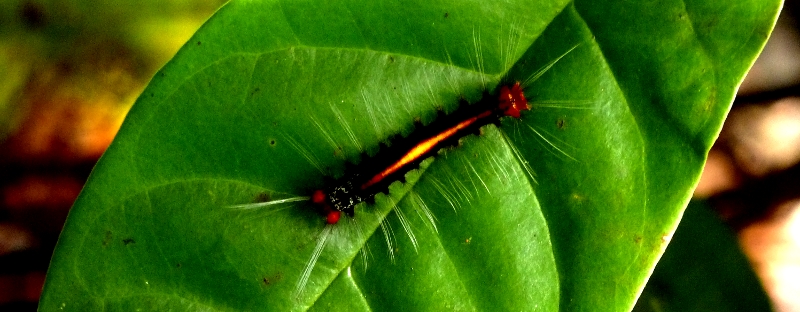About theory and practice
How can you tell if a snake is poisonous? That would already be an interesting topic for a theoretical biology lesson. Now imagine learning about it while you are actually holding a snake in your hands! Just a few weeks ago, a friend of mine had caught a small serpent on our campus, and a fellow master student used the occasion for some spontaneous explanations. See how the snake’s head has a triangular shape, and the scales on its forehead are bigger than on the rest of the body? That means our little case study here is harmless. Non-venomous snakes have a longer tale too – yes, it’s actually possible to distinguish between the body and the tale of a serpent, although I wouldn’t recommend to try that if you come across a snake you don’t know in the jungle…
There is no better way to really learn something than to combine theory and practice. In the field of environmental studies, the Amazon is the perfect place to do just that.
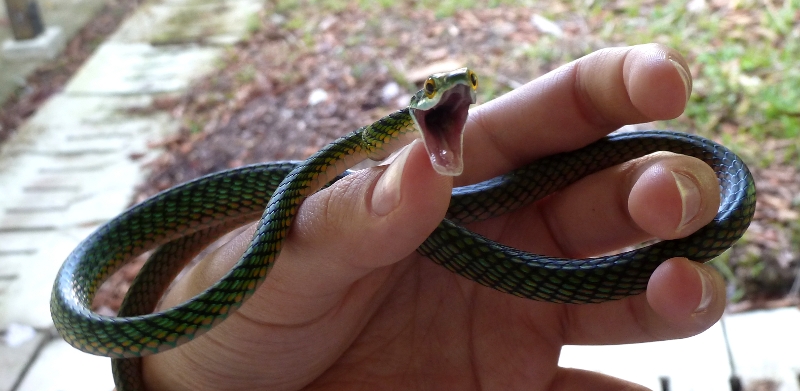
Besides snakes, this region has quite a lot of interesting flora and fauna to offer. There are many theories about the origin of the Amazonian biodiversity, and we have discussed several in my classes. One important factor certainly is the geological history of the region, including the uplift of the Andes and the following erosion processes that led to the creation of the Amazonian lowlands in a formerly marine environment. This could explain why many former saltwater species have evolved in the region’s freshwater systems. The pink dolphin is certainly the most famous example, protector of the jungle and protagonist of many tales and legends. To the indigenous people, he is known as bufeo, legendary seducer of women and master of pretense.
In contrast to his oceanic cousins, the pink dolphin is capable of turning his head flexibly when foraging for food in the flooded forests. His calves are born with a dark gray color, loosing it slowly as the years go by. The grown-up adult might be more than two meters long and is usually at least partly pink-colored. It is an impressive sight to see this massive body plow through the water, herding swarms of fleeing fish in front of him. Unfortunatelly, taking a photo of a diving dolphin is rather difficult.
Not only the geological history of the region has shaped the composition of its species. Migration processes and climate variations have also played their role, as well as several thousand years of human interaction. Today, the many rivers might still provide barriers broad enough to allow the evolution of distinct species on either side. On of the most interesting theories, however, is the concept of ecological gradients. It refers to the spatial variation of environmental factors such as soil type, climate conditions or water availability. In their transition zones, different species of plants might evolve side by side, as they adapt to their individual habitat conditions.
So far the theoretical concepts, now lets get a feeling for what they mean. Let us return to the jungle. On October 4th to 6th, I went on a one-weekend field trip with my class of Amazonian geography and ecology. We spent three days at the indigenous community Monilla Armena, 13 km outside of town. On October 24th to 26th, I left Leticia again, this time accompanying another ecology class to Puerto Nariño, a small town about two hours upriver by speedboat. In both cases, I gained impressive new insights into la Selva.
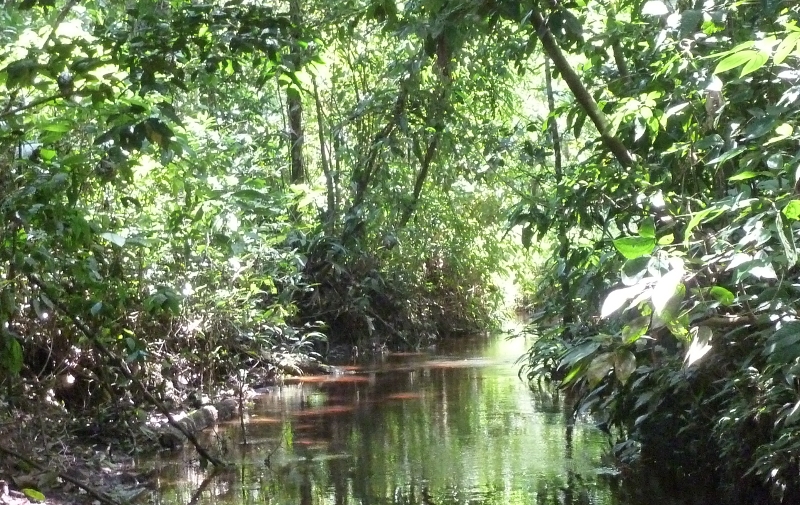
An excellent example of ecological gradients can be found in almost all areas around the Amazonian rivers, at the transition zone between the floodplains and firm earth. In the floodplain forests known as varzeas, nutrient-rich riverine sediments fertilize the soil. This allows for other species of plants to grow than on the poorer soils in other parts of the jungle. Moreover, the varzea’s vegetation is well-adapted to the frequent floodings. Some species use free standing root systems to stabilize their stems and secure oxygen supply during high-water season, and a few even depend on fish feeding on their fallen fruits for seed dispersal. We observed some of these features on our trip to Monilla Armena, where we went on a walk through the varzea closeby.
When we finally reached the firm earth forest, the vegetation type changed drastically. Just a few meters more of altitude marked a complete change of ecological conditions, creating a completely different habitat. La Selva de tierra firma is characterized by a more stable, stratified structure. Its dense understory is formed by smaller plants that would probably drown in the floodplain, and the closed canopy consists of different species of taller trees. I had only seen secondary firm earth forests before, land reclaimed by the jungle after deforestation. In contrast, some of the trees we encountered here had seen the times before the Spanish conquest, witnesses of six hundred years of local history.

Those giant tree trunks were quite a splendid sight – and yet I might have liked to see a little more than trunks alone. This is the disadvantage of the multi-story structure of tropical canopies, there is always a smaller tree blocking the view on the highest branches. Staring up from below, I knew nearly nothing about those ancient giants, neither the size or shape of their leaves nor the flowers or fruits they might be bearing. Yet our indigenous host would identify them all, observing nothing but the trunk alone. What is the color of its bark, its structure and consistency? What does the wood look like, does it bleed milk or resin when being cut with a machete? What is its smell, its sound upon beating? He would know them all. That one has good wood for constructions, this one is used for handicrafts, that tree has medical properties. Naming them, however, was yet a different matter. Most plants bear different names in Colombia, Brasil and Peru, as well as in the many indigenous tongues of the region. In this context you learn to appreciate the clear concept of scientific taxonomy!
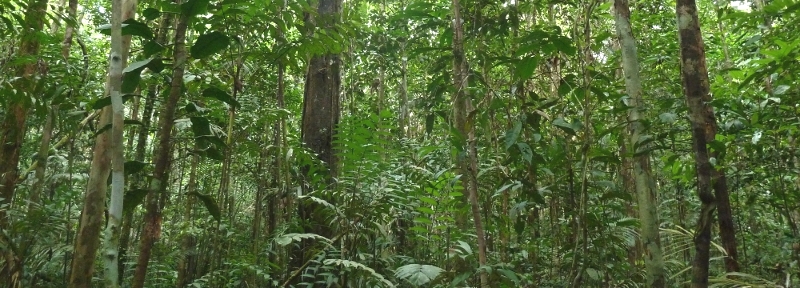
Identifying plants was also one of our tasks during the field trip to Puerto Nariño. The jungle there is yet again completely different. In contrast to the level lowlands around Leticia, Puerto Nariño faces the flank of hard rock hill structures dating back to the Tertiary age. The valley vegetation is a darker, denser form of forest, whereas each hill crest bears a higher, lighter type of growth. Here again, ecological gradients cause a frequent change of species composition, clearly contributing to the local plant diversity.
To quantify the species richness of the area, we conducted a practical fieldwork at a parcel of the forest floor. First we marked rectangular areas with rulers, ropes and stakes, then asked our indigenous guides for the common names of any plant we found in them. Within only five square meters of the forest floor, my team encountered 19 species of plants - and that has been a rather empty area. Once again, theory and practice went hand in hand. Moreover, crawling around on the ground to conduct even such a small-scale investigation has definitely changed my perception of the large-scale scientific research projects we read about in class.
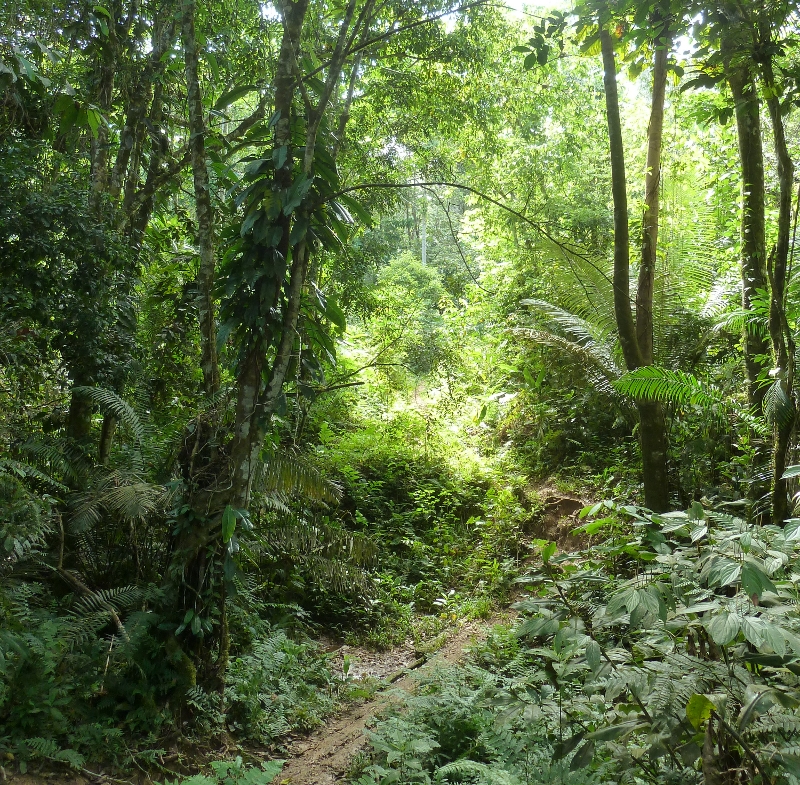
Of course we did not only identify plants on our walks through the jungle. Around Puerto Nariño, our path led us through sun-speckled spaces of breathtaking beauty like the one above, I must have taken about a thousand photos on that trip. During my time at Monilla Armena, there were lovely little forest streams to be discovered, and rivers to be crossed on natural and not-so-stable bridges. On one of our walks, we left the common paths for a “shortcut” that our host cleared for us with his machete, leading us right into the woods. On another occasion, he would show us a place where we could swing on a liane like Tarzan – not very far though, if we did not want to crash into the closest trees.
During our hikes in the jungle, we also learned to keep our eyes open for insects of all kinds. There were ant hills hanging in the trees, butterflies sleeping below their branches, and cicada tunnels leading straight down into the earth. At one point I walked into a very colorful bug, some kind of caterpillar it seemed, which did sting nastily right through my clothing. And another time, our guide accidentally stirred one of the little wasp nests well-hidden under large deep-hanging leaves - it was the only time I ever saw him running. Reading about the diversity of insects in the Amazon does not nearly come close to these sensations. No theoretical lesson could possibly replace a practical experience like this.
Talking about biodiversity in theory and practice, the Amazon is just the place to go.
